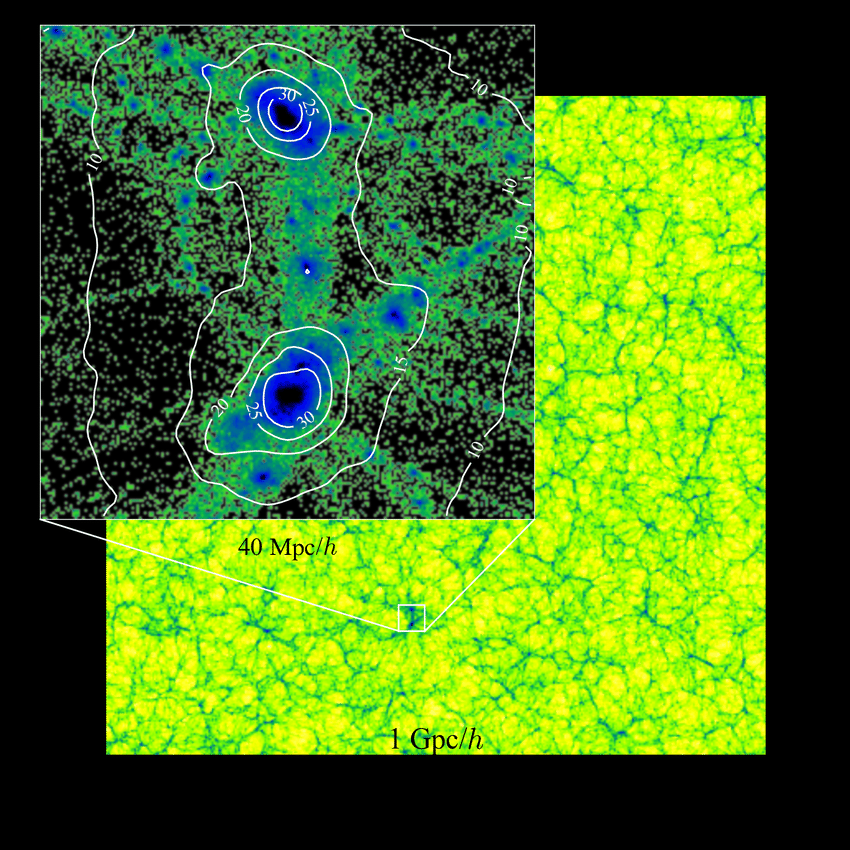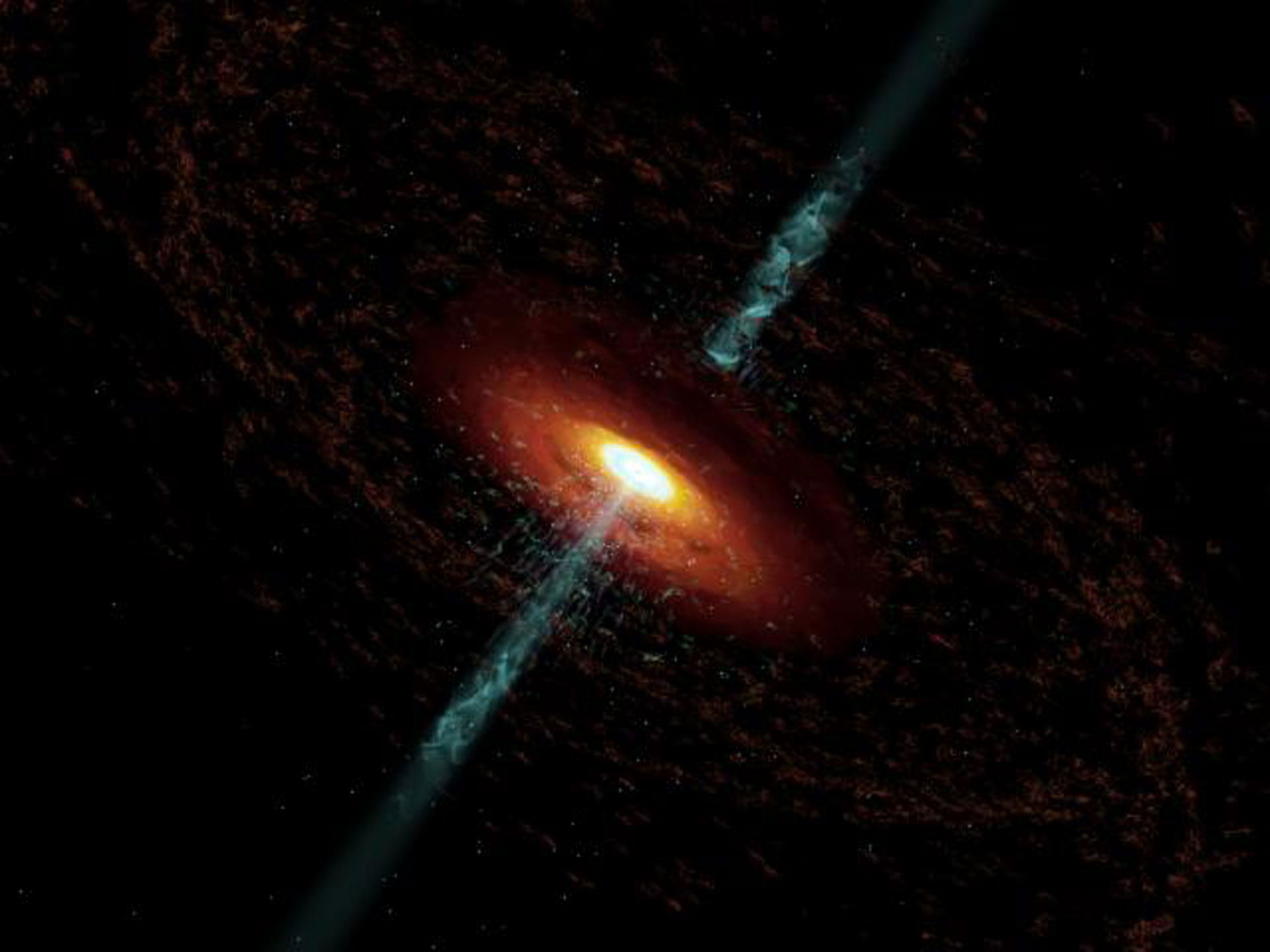physics page

Dark Matter
You can see normal Matter, you can do 'chemistry' with it and it is attractive
Dark Matter is only
attractive
The observational results were clear:
on the one hand, some stars near the nucleus of some galaxies showed
extreme trajectories and, on the other hand, the galaxy arms did not
move as expected.
In order not to question the general theory of
relativity, physics had to invent enormous amounts of invisible 'dark' matter. The strange trajectories near the galactic
nucleus are now usually explained by suspected black holes.
The
strange behavior of the galaxy arms could only be explained
by enormous amounts of dark matter, which must be specially
distributed in the arms and must be closer and denser towards the
center of the galaxy.
Just have a look at the
Wiki for background.
The term ́dark matter ́ does not
stand for a substance, but for an observed effect. We only call this
'dark matter' because we associate gravity (the mutual attraction)
exclusively with heavy matter visible to us. A gravitational effect without a
material cause is inconceivable for us - and in fact this also
disturbed the physicists.
The cohesion of the material objects of Quantum Mechanics (QM)
is based on object-internal forces. With the help of standardization
methods, QM can calculate correctly without considering an
interaction of the outside/world background with the object. The
space of quantum mechanics (the quantum vacuum) always has a positive
energy content. Out of this quantum vacuum new matter is constantly
created, but it immediately dissolves into it - like foam combs in
the ocean. See for example here.
So we inend to come to a vivid picture of a process in which an enormous, very locally concentrated gravity arises - the 'black hole' and also to picture of a process that could be responsible for the strange, wagonwheel-like motion of entire galaxies.
What about black holes
Black holes are characterized by an enormous attractiveness, which emanates from an extremely small area of space (Schwarzschild radius) that cannot be 'seen' directly. According to the observations dark matter is mainly suspected there (dark blue in the image below):

What might a process that produces dark
matter look like?
We read above that matter can arise from the
quantum vacuum. Since heavy matter is a very concentrated form of
energy there must be a loss of energy in this quantum vacuum during
the process of formation of matter. If this matter immediately
dissolves into the quantum vacuum, this will have no visible effect
on the energy content of the quantum vacuum at this point.(->here)
The effect of vacuum energy can be seen as a kind of
pressure that acts on the environment from a section of the room. As
a rule, the balance to the environment does not change spontaneously,
but if part of the vacuum energy condenses into new matter in a
section of space without immediately decaying, then this pressure -
the 'unbound' vacuum energy - must fall in relation to the amount of the
condensed matter.
In order to get an idea of the process, we again
try the interaction principle described here, according to which
space and matter form an inseparable unity.
Heavy matter is stable and resonantly
vibrating wave packets in a space filled with momentum-bearing
objects, and quantum mechanics sees it the same way. However, the
material object is not always called a wave packet or resonance, but
often also a harmonic oscillator. In our model of gravity, a section
of space in which matter forms from vacuum energy would be very, very
violently attractive to its environment.
Gravity would be the result
of the accumulation of a lot of momentum needed to form matter waves.
From the outside you can not necessarily 'see' this formation of
matter - a resinous hole does not let any rays of light outside. We
have already illustrated the enormous energy density of heavy matter here.
The new matter would disappear into the black hole and the vacuum energy condensed into it would trigger the enormous attractiveness (gravity) of the black hole. A black hole would thus be an object that converts vacuum energy into heavy matter and/or EM wave packets and is therefore enormously atractive. Of course, the new matter would then have to go somewhere. Either the black hole accumulates them in itself and gets bigger. Or it finds a way to get rid of a part of it anyhow. Perhaps as a jet of matter that goes into space orthogonally to the plane of rotation of the black hole. We already know these jets ...

What about Spiral Galaxies
When an extended system held together by gravity rotates, the outer objects are expected to move more slowly than the inner ones. After all, gravity must balance itself with the centrifugal forces, otherwise the object either falls into the center or flies away completely. Gravity decreases from the inside to the outside - ergo, the rotational speed generated by the centrifugal force must also decrease.
Spiral galaxies however often showed otherwise, because the
galaxies behaved more like a wagon wheel - they were stiff! This,
too, ultimately prompted physics to introduce dark matter. It should
be embedded in the arms and thus bring about the rigidity of the
entire structure. There are animations on the net and also graphics
in 3D, how and in what concentration the dark matter would have to be
localized in the galaxy arms in order to cause the observed behavior. See for example here.
Now the gravitational effect of mass in our perception is the result of the very weak interaction (10 exp-120 impulse -> angular momentum) of the ICO (ImpulseContainingObject) stream coming from universe with heavy matter.
From the heavy matter an altered impulse current goes back into space. The ratio of momentum to angular momentum of the ICO is changed after the Interaction in favor of angular momentum, which has an effect on the attractive effect on other heavy matter (gravity) and also on the light waves in space (light deflection in the gravitational field).
The properties of the quantum vacuum are thus changed in a certain way by the interaction with the heavy masses in it. Part of the momentum of the ICO becomes angular momentum, while the total energy per volume of space generally remains the same. The deeper you dive into a collection of matter such as a galaxy or star clusters, the more frequently the ICOs from the world background have already interacted with matter from the galaxy. Each time there will be a further shift in the ratio of momentum > angular momentum. Inside such accumulations of matter the quantum vacuum will have different properties than far away from these accumulations.
The ever-increasing proportion of angular momentum will be at the expense of the linear impulse of the ICO. Duie Differnz gets stronger the further we get inside. Now, however, the internal angular momentum of an ICO at WW with a heavy matter wave causes an orthogonal - i.e. transverse to the direction of movement of the ICO - momentum. If one compares both regions - far out and deep inside - one comes to the conclusion that in WW with heavy matter far out because of the higher linear momentum of the ICO, the attractive-looking effect per unit mass should be greater than in WW of the same unit mass with the correspondingly weaker ICO inside the galaxy or the cluster. At the same object of matter, there should be a weaker gravitational effect in the middle of the accumulation than outside. This would correspond to a changing gravitational constant. It should weaken.... We may have heard of this before: MOND.
Barriers to equilibrium
QM allows heavy matter to arise
incessantly from the quantum vacuum and perish again in it. It is
obvious to see this emergence and decay as a process of equilibrium
that is stable in a range of environmental conditions.
At the edges
of the condition spectrum, the equilibrium process becomes unstable,
after all, this is the characteristic of all equilibrium processes -
they can 'tilt'.
A first edge of the stability conditions (1) is a
quantum vacuum in which the angular momentum of the ICO is dominant
over its momentum. This would correspond to the state inside
accumulations of matter. The instability of the equilibrium process
is then shown by the fact that more matter is created from the
quantum vacuum than immediately decays again.
If we assume a one-dimensional relationship, the other edge of the stability conditions (2) will be a quantum vacuum in which the momentum of the ITO is dominant over the angular momentum. The equilibrium process should now 'tilt' in the other direction.
So no new matter will arise there, but the opposite is to be expected and the matter present in this space will become unstable and threaten to decay.
Fermions and bosons would then disappear from our perception. The energy previously contained in them enters the vacuum energy and becomes 'pressure', the impulse current going from the decay site into the environment will increase. Read more here.
The genesis of matter under ambient conditions (1) will therefore result in a locally triggered, enormous attraction.
Under ambient conditions case (2) results exactly the opposite, a widely diffuse repulsion.
The question is obvious:
Are there indications or observations that suggest the environmental conditions (1) or (2) favorable for attraction / repulsion?
I guess Yes:
By the way, QM says that the position of wave packages (matter waves) near electromagnetic fields can be
predicted quite accurately. The matter waves are apparently kept
'small and compact' by the presence of an electromagnetically vivid
environment.
On the other hand, the longer they traveled through the
void, the less accurate the prognosis for the location of matter
waves after long passages in a vacuum and in the absence of fields.
Matter waves apparently 'diverge' there, at least the prediction
possibilities for the expected location statistically deteriorate to
more and more spaces, the longer the matter waves travel undisturbed
in an environment without gradient.